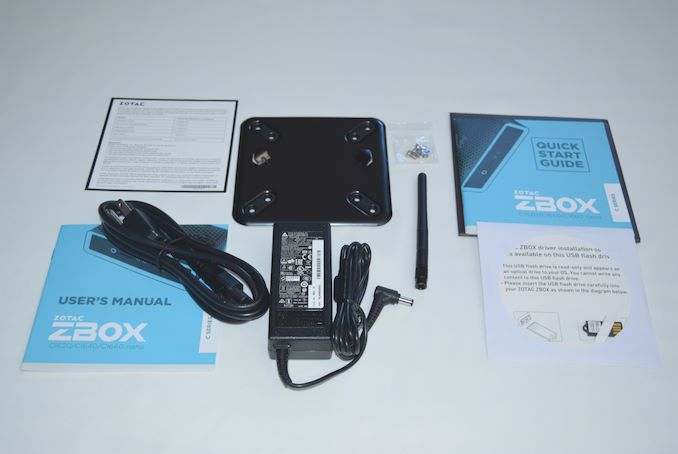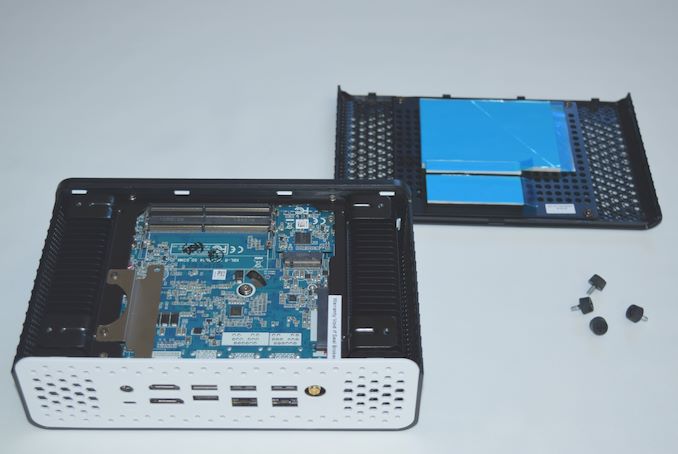The Zotac ZBOX CI660 nano Fanless mini-PC Review: A Promising HTPC Platform
by Ganesh T S on April 16, 2019 8:15 AM EST
Zotac is a major player in the SFF PC space, and the emergence of the ultra-compact form-factor (UCFF) NUCs has broadened the available market for ther mini-PCs. The company markets their passively-cooled machines under the C-series moniker. Their C-series nano units adopt a form-factor very similar to Intel's NUCs, providing performance and thermal efficiency commensurate with their size.
The company's latest models, the CI6xx nano units, are based on the Kaby Lake-Refresh U-series processors, and they aim to improve on the older C-series units by adopting a larger form factor and adding more platform features. The larger form factor should, in theory, be able to accommodate a better-performing cooling system. The added platform features should be able to broaden the addressed markets. But how well does Zotac fare with respect to these goals? This review aims to provide some answers.
Introduction and Platform Analysis
The Zotac ZBOX CI660 nano belongs to the company's passively-cooled C-series family. It is based on the Kaby Lake-R U-series SiPs (KBL-R U). We had reviewed the Zotac CI523 nano back in 2016. At that time, we had appreciated what Zotac had done by introducing an affordable fanless high-performance computing system for the average consumer. The CI523 nano, which was based on a 15W TDP Core i3-6100U, was slightly larger than the CI540 nano (based on a 11.5W Haswell-Y SiP).
Zotac's new CI660 nano, by contrast, eschews the square-base form factor of the previous C-series PCs for a rectangular board. The larger board area also allows Zotac to integrate dual gigabit Ethernet ports (compared to the single port in the CI523 nano). The larger heat-sink allows for the integration of the Core i7-8550U, a processor with a 15W TDP that can also be configured for operation at 7.5W or 25W.
The CI660 nano is available barebones, or, in a PLUS model with RAM and SSD (no OS). The latter is priced at $700. Zotac supplied us with a barebones model for review, and we utilized a Crucial BX300 480GB 2.5" SATA SSD and two Patriot Memory DDR4-2800 SODIMMs to complete the build.
The specifications of our Zotac ZBOX CI660 nano review configuration are summarized in the table below.
| Zotac ZBOX CI660 nano Specifications | |
| Processor | Intel Core i7-8550U Kaby Lake Refresh-U, 4C/8T, 1.8 (4.0) GHz 8MB L2, 15 W TDP |
| Memory | Patriot Memory 2800 C18 Series PV432G280C8SK DDR4 SODIMM 18-18-18-43 @ 2800 MHz 2x16 GB |
| Graphics | Intel UHD Graphics 620 |
| Disk Drive(s) | Crucial BX300 (480 GB; 2.5" SATA III SSD; IMFT 32L 3D MLC) |
| Networking | Intel Dual Band Wireless-AC 3165 (1x1 802.11ac - 433 Mbps) 2x Realtek RTL8168 (MAC) / RTL8111 (PHY) Gigabit Ethernet controller |
| Audio | 3.5mm Headphone Jack Capable of 5.1/7.1 digital output with HD audio bitstreaming (HDMI) |
| Miscellaneous I/O Ports | 5x USB 3.0 Type-A 2x USB 3.1 Gen 2 Type-C 1x SDXC UHS-I |
| Operating System | Retail unit is barebones, but we installed Windows 10 Enterprise x64 |
| Pricing | $700 (PLUS model with a 4GB DDR4 SODIMM and a 120GB SSD) $865 (as configured, no OS) |
| Full Specifications | Zotac ZBOX CI660 nano Specifications |
The Zotac ZBOX CI660 nano kit comes with a quick-start guide, user's manual, hardware for VESA mounting, bunch of screws for installing the storage drive, and a 65 W (19V @ 3.42A) adapter with a US power cord. A read-only USB drive with the requisite drivers is also bundled.
The gallery below takes us around the chassis design. Note that the unit is liberally perforated, allowing for easier convective heat dissipation.
Access to the SATA drive bay and the SODIMM slots is tool-less, as is typical of Zotac's mini-PCs. Unscrewing the base also reveals the ASMedia ASM2142 daughterboard that enables the two USB 3.1 Gen 2 Type-C ports. The base itself has thermal pads mounted for the RAM sticks as well as the SSD.
The heat sink fins revealed by the removal of the base fully envelopes the top segment of the board. The gallery below takes us around the unit as it is subject to additional teardown.
Platform Analysis
The Core i7-8550U package integrates an Intel Cannon Point-LP platform controller hub (PCH). While Zotac doesn't document the board layout in detail, the distribution of the PCIe lanes from the SiP is brought out in the system report summary generated by AIDA64:
- PCI-E 3.0 x1 port #3 In Use @ x1 (Realtek RTL8168/8111 PCI-E Gigabit Ethernet Adapter)
- PCI-E 3.0 x1 port #4 In Use @ x1 (Realtek RTL8168/8111 PCI-E Gigabit Ethernet Adapter)
- PCI-E 3.0 x1 port #5 In Use @ x1 (Intel Dual Band Wireless-AC 3165 AC HMC WiFi Adapter)
- PCI-E 3.0 x4 port #9 In Use @ x2 (ASMedia ASM2142 USB 3.1 xHCI Controller)
Unlike the Bean Canyon NUC's CNVi Wi-Fi built into the PCH, the CI660 nano has to use one of the PCIe lanes to support the Intel Wireless-AC 3165 WLAN adapter. The USB 3.1 Gen 2 ports also have to be enabled by a discrete ASMedia ASM2142 bridge. We have two gigabit Ethernet ports, and both are enabled by Realtek controllers.
The HDMI display output from the CI660 nano is not directly from the SiP's HDMI display output. Rather, Zotac uses a Parade Technologies PS175 LSPCon on board to convert the Display Port 1.2 output of the processor to a HDMI 2.0 port with HDCP 2.2. Theoretically, this also supports HDR. However, stereoscopic 3D is not supported.
In the table below, we have an overview of the various systems that we are comparing the Zotac ZBOX CI660 nano against. Note that they may not belong to the same market segment. The relevant configuration details of the machines are provided so that readers have an understanding of why some benchmark numbers are skewed for or against the CI660 nano when we come to those sections.
| Comparative PC Configurations | ||
| Aspect | Zotac ZBOX CI660 nano | |
| CPU | Intel Core i7-8550U | Intel Core i7-8550U |
| GPU | Intel UHD Graphics 620 | Intel UHD Graphics 620 |
| RAM | Patriot Memory Viper PV432G280C8SK DDR4 SODIMM 18-18-18-43 @ 2800 MHz 2x16 GB |
Patriot Memory Viper PV432G280C8SK DDR4 SODIMM 18-18-18-43 @ 2800 MHz 2x16 GB |
| Storage | Crucial BX300 (480 GB; 2.5" SATA III; Micron 32L 3D MLC) |
Crucial BX300 (480 GB; 2.5" SATA III; Micron 32L 3D MLC) |
| Wi-Fi | Intel Dual Band Wireless-AC 3165 (1x1 802.11ac - 433 Mbps) |
Intel Dual Band Wireless-AC 3165 (1x1 802.11ac - 433 Mbps) |
| Price (in USD, when built) | $625 (barebones) $865 (as configured, No OS) |
$625 (barebones) $865 (as configured, No OS) |






















23 Comments
View All Comments
jgraham11 - Tuesday, April 16, 2019 - link
BAPCo's SYSmark 2018 is an application-based benchmark that has been developed by Intel engineers for Intel CPUs and does not truly reflect performance of any real world application by any other chip vendor. The fact that every other chip maker have all abandoned Bapco's boards tell you something. This is a known conflict of interest that degrades Anandtech's credibility by highlighting it. At least in the past the articles, these conflicts were pointed out regarding Bapco's shaky past.Daeros - Tuesday, April 16, 2019 - link
Anandtech's quality has been on a continuous downward slide, including increasing Intel/Nvidia bias, ever since Anand left. The site looks and sounds like it's written by children now - especially including comments the editorial staff post in comments sections and on twitter.Eris_Floralia - Tuesday, April 16, 2019 - link
Hey what about my AndreiDigitalFreak - Tuesday, April 16, 2019 - link
While I would agree that the quality is not near as good as it was when Anand was around, I don't see any bias.PeachNCream - Thursday, April 18, 2019 - link
Read literally anything written about a Killer NIC.rrinker - Tuesday, April 16, 2019 - link
Seems like this article only compares Intel systems to other Intel systems - so what's the problem? Other than, of course, this article does not agree with some personal bias of yours, therefore all of Anandtech is now not credible, etc. A little extreme reaction don't you think? But such is the way witht he extremism in EVERYTHING these days. Social media has destroyed any chance for critical thinking. Anandtech does an article that's positive towards Intel, OMG BIASED, They hate AMD. They write a different article that's positive towards an AMD product - OMG BIASED! Why the hate on Intel?Irata - Tuesday, April 16, 2019 - link
Yup, using a benchmark by Bapco in which no chip company besides Intel seems to have confidence does leave a rather bad taste.nVidia, AMD and VIA all left the consortium back in 2011 and prior to that Bapco was found to have modified their benchmarks in a way that favored Intel CPU
Ryan Smith - Wednesday, April 17, 2019 - link
SYSmark 2018 is one of several tools we use in this article. It is certainly not the only tool we use, and it's not a tool we use in all situations (e.g. architecture deep dives). Meanwhile for SFF PCs in particular, its power measurement capabilities are pretty handy to have. Plus the only other systems we're comparing it to are all Intel-based anyhow.MDD1963 - Thursday, April 18, 2019 - link
If BAPCO SYSMark was developed by Intel engineers, this would seem more an issue if/when comparing Intel systems to AMD, and not really an issue when comparing all Intel systems...mammothboy - Tuesday, April 16, 2019 - link
The Realtec NICs may be a blessing for use with Windows Server (Intel has a nasty habit of not providing drivers for many of their NICs). Having two will let you set up a team there (perhaps to use as a AD/DNS server) or use as a firewall/router (not that I'd use Windows Server for either).I've generally had good luck with Realtec with Windows Server and PFSense.